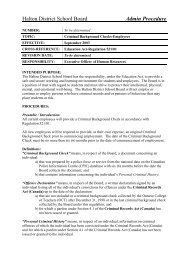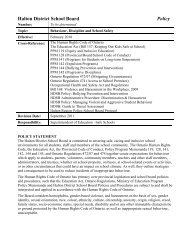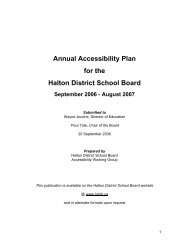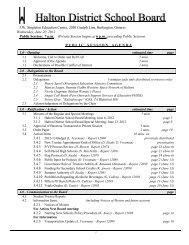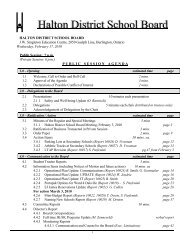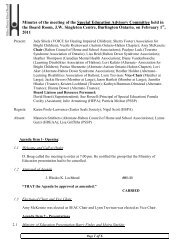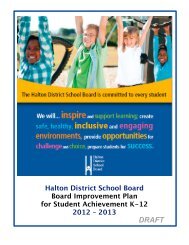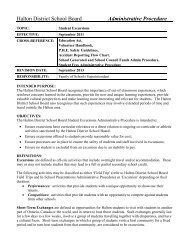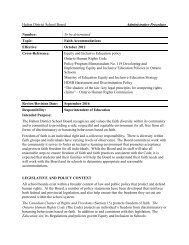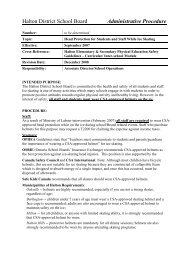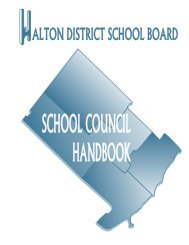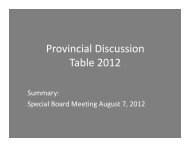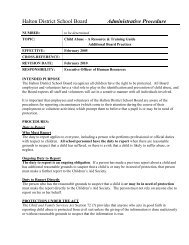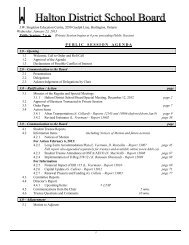Supporting English Language Learners in Grades 1 to 8
Supporting English Language Learners in Grades 1 to 8
Supporting English Language Learners in Grades 1 to 8
You also want an ePaper? Increase the reach of your titles
YUMPU automatically turns print PDFs into web optimized ePapers that Google loves.
Specific expectations<br />
Social Studies<br />
Knowledge and understand<strong>in</strong>g<br />
••<br />
Identify some scientific and technological advances made<br />
by two or more early civilizations (e.g., written language,<br />
calendar, time-keep<strong>in</strong>g methods, <strong>in</strong>vention of the<br />
wheel, medic<strong>in</strong>e, sculpture, irrigation, build<strong>in</strong>g methods,<br />
architecture, embalm<strong>in</strong>g, aqueducts, metal work).<br />
Inquiry/research and communication skills<br />
••<br />
Use primary and secondary sources <strong>to</strong> locate <strong>in</strong>formation<br />
about early civilizations (e.g., primary sources: artefacts,<br />
field trips; secondary sources: atlases, encyclopedias<br />
and other pr<strong>in</strong>t materials, illustrations, videos, CD-ROMs,<br />
Internet sites).<br />
Application<br />
••<br />
Make connections between some elements of modern<br />
life and similar elements from early civilizations (e.g.,<br />
the Olympic ideal, democracy, money as a medium of<br />
exchange, citizenship, philosophy, mythology, trade,<br />
social structures, legal systems, theatre, architecture).<br />
Unit overview<br />
Specific expectations (Modifications)<br />
Benjime: Us<strong>in</strong>g a visual representation, such as a timel<strong>in</strong>e<br />
or a poster board, show how a scientific or technological<br />
advance of an early civilization has changed over time and<br />
has eventually <strong>in</strong>fluenced modern civilization (e.g., <strong>in</strong>vention<br />
of the wheel, sculpture, build<strong>in</strong>g methods, architecture,<br />
metal work).<br />
M<strong>in</strong>-su and Olesya: Modifications are not necessary.<br />
Accommodations outl<strong>in</strong>ed <strong>in</strong> this unit will support their<br />
learn<strong>in</strong>g.<br />
Benjime: Use teacher-selected sources/materials <strong>to</strong> locate<br />
<strong>in</strong>formation about an early <strong>in</strong>novation.<br />
M<strong>in</strong>-su and Olesy: Modifications are not necessary.<br />
Accommodations outl<strong>in</strong>ed <strong>in</strong> this unit will support their<br />
learn<strong>in</strong>g.<br />
Benjime: Match some elements of modern life <strong>to</strong> similar<br />
elements from an early civilization (e.g., cemetery and<br />
pyramid, hieroglyphs and writ<strong>in</strong>g, paper and papyrus).<br />
••<br />
Report on the relevance <strong>to</strong> modern society of selected<br />
scientific and technological discoveries made by early<br />
civilizations (e.g., written language, astronomy, irrigation,<br />
mathematics, navigational <strong>in</strong>struments, medic<strong>in</strong>e,<br />
architecture, the m<strong>in</strong><strong>in</strong>g and smelt<strong>in</strong>g of metals).<br />
<strong>Language</strong><br />
Oral communication<br />
2.3<br />
Communicate orally <strong>in</strong> a clear, coherent manner, present<strong>in</strong>g<br />
ideas, op<strong>in</strong>ions, and <strong>in</strong>formation <strong>in</strong> a readily understandable<br />
form (e.g., present an argument that has a clearly stated<br />
purpose, po<strong>in</strong>t-by-po<strong>in</strong>t development, and relevant<br />
support<strong>in</strong>g details).<br />
2.7<br />
Use a variety of appropriate visual aids (e.g., posters, charts,<br />
maps, globes, computer-generated organizers) <strong>to</strong> support<br />
or enhance oral presentations (e.g., use m<strong>in</strong>istry-licensed<br />
software <strong>to</strong> create a Venn diagram <strong>to</strong> compare two different<br />
biographies).<br />
Writ<strong>in</strong>g<br />
1.3<br />
Gather <strong>in</strong>formation <strong>to</strong> support ideas for writ<strong>in</strong>g, us<strong>in</strong>g a<br />
variety of strategies and a range of pr<strong>in</strong>t and electronic<br />
resources (e.g., <strong>in</strong>terview people with knowledge of the<br />
<strong>to</strong>pic; identify and use graphic and multimedia sources;<br />
keep a record of sources used and <strong>in</strong>formation gathered).<br />
M<strong>in</strong>-su and Olesya: Modifications are not necessary.<br />
Accommodations outl<strong>in</strong>ed <strong>in</strong> this unit will support their<br />
learn<strong>in</strong>g.<br />
Benjime: Identify some discoveries of early civilizations <strong>to</strong><br />
show how they are still used <strong>to</strong>day.<br />
M<strong>in</strong>-su and Olesya: Modifications are not necessary.<br />
Accommodations outl<strong>in</strong>ed <strong>in</strong> this unit will support their<br />
learn<strong>in</strong>g.<br />
2.3<br />
Benjime: Communicate orally us<strong>in</strong>g short, rehearsed words<br />
and phrases (e.g., make a short presentation about a chosen<br />
<strong>to</strong>pic).<br />
M<strong>in</strong>-su and Olesya: Modifications are not necessary.<br />
Accommodations outl<strong>in</strong>ed <strong>in</strong> this unit will support their<br />
learn<strong>in</strong>g.<br />
2.7<br />
No modification of this expectation is necessary for these<br />
ELLs s<strong>in</strong>ce visual aids are essential for their comprehension<br />
of the concepts <strong>in</strong> this unit. The number and complexity of<br />
the visual aids may need <strong>to</strong> be adjusted for Benjime.<br />
1.3<br />
Benjime: With scaffold<strong>in</strong>g, copy words and phrases <strong>to</strong><br />
record <strong>in</strong>formation on a graphic organizer, or glue strips<br />
of prepared words and simple phrases <strong>in</strong> the appropriate<br />
places on the graphic organizer.<br />
M<strong>in</strong>-su: Modification is not necessary. He will be supported<br />
through scaffold<strong>in</strong>g such as teacher-selected resources that<br />
are at an appropriate level and <strong>in</strong>clude strong visuals.<br />
Olesya: Modifications are not necessary. Accommodations<br />
outl<strong>in</strong>ed <strong>in</strong> this unit will support her learn<strong>in</strong>g.<br />
76<br />
<strong>Support<strong>in</strong>g</strong> <strong>English</strong> <strong>Language</strong> <strong>Learners</strong> <strong>in</strong> <strong>Grades</strong> 1 <strong>to</strong> 8



